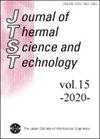横向振动管道内空间展开对对流换热强化的影响
IF 1.2
4区 工程技术
Q3 THERMODYNAMICS
引用次数: 2
摘要
本研究模拟了催化转化器多分支下游管内的流动结构。采用直接数值模拟方法分析了细圆直管内的对流换热问题。在管道上施加强制横向振动以增强传热。主计算域足够长,可以捕捉在流入-流出边界条件下振动效应的空间发展。将代表性雷诺数设置为小于产生主域湍流流入的驱动域中的代表雷诺数。努塞尔数的分布表明,振动对传热的积极影响在某些下游位置变得明显。其位置距离短,高振动频率保持振幅恒定。在换热增强区域,高温主流在振动方向上交替向管壁一侧和另一侧移动,并出现有组织的流向涡。在目前的空间发展构型中,流动结构主要受振动频率的控制,尽管末端传热性能近似是振动速度幅值的函数。本文章由计算机程序翻译,如有差异,请以英文原文为准。
Effect of spatial development on convective heat transfer enhancement in a pipe with transverse vibration
The present study models the flow configuration in a tube downstream of multi-branching in a catalytic converter. Convective heat transfer in a thin circular straight pipe is analyzed by direct numerical simulation (DNS). Forced transverse vibration is applied to the pipe itself to enhance the heat transfer. The main computational domain is sufficiently long to capture the spatial development of the vibration effect with the inflow-outflow boundary condition. The representative Reynolds number is set to be less than that in a driver domain which generates the turbulent inflow of the main domain. Profiles of the Nusselt number exhibit that the positive effect of the vibration on the heat transfer becomes apparent at certain downstream locations. The distance to its location is short with the high vibration frequency keeping the amplitude constant. In the region where the heat transfer is enhanced, the main flow with high temperature is shifted to one side and the other side of the pipe wall in the vibration direction alternatingly with the appearance of the organized streamwise vortices. The flow structure in the present spatially developing configuration is governed mainly by the vibration frequency although the terminal heat transfer performance is approximately a function of the velocity amplitude of the vibration.
求助全文
通过发布文献求助,成功后即可免费获取论文全文。
去求助
来源期刊
CiteScore
2.30
自引率
8.30%
发文量
0
审稿时长
5 months
期刊介绍:
JTST covers a variety of fields in thermal engineering including heat and mass transfer, thermodynamics, combustion, bio-heat transfer, micro- and macro-scale transport phenomena and practical thermal problems in industrial applications.

 求助内容:
求助内容: 应助结果提醒方式:
应助结果提醒方式:


